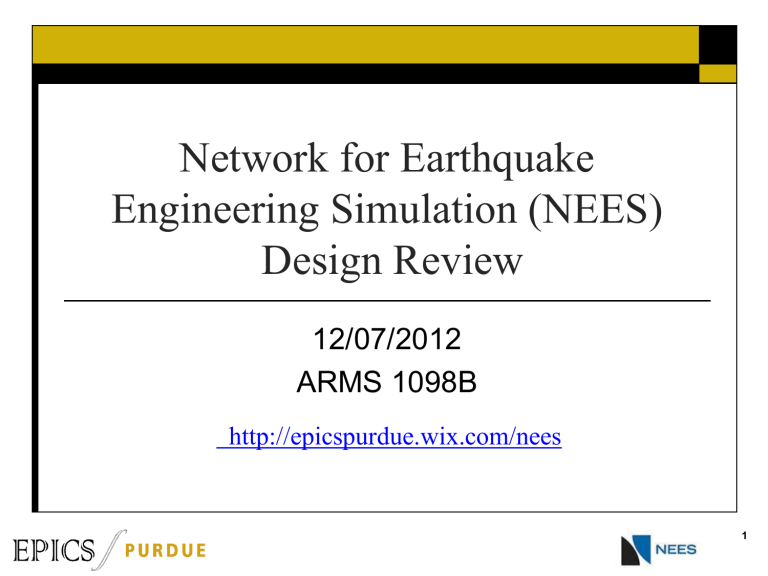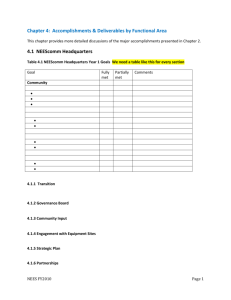NEES Network for Earthquake Engineering Simulation

Network for Earthquake
Engineering Simulation (NEES)
Design Review
12/07/2012
ARMS 1098B http://epicspurdue.wix.com/nees
1
•
•
•
•
•
•
•
Agenda
Introduction
Overview of NEES
Clients needs and requirements
Project overview
Project 1: Shake Table
Project 2: Interface
Open Discussion
2
Project Partner
NEES
Network for Earthquake
Engineering Simulation
14 Large scale test facilities dedicated to research needed to reduce risks caused by earthquakes and tsunamis
3
Our clients from NEES
Dr. Keith Adams
Director of Education Outreach and Training
Pamela McClure
Education Outreach and Training
207 S. Martin Jischke Dr, Suite 301
West Lafayette, In 47907
4
NEES EOT – Client Goals
Increase public awareness of NEES, its research and its mission
Bring science and engineering to classrooms
Raise student’s interest in earthquake engineering and science
Popular NEES Outreach Activity
Make Your Own Earthquake System
PC Display
PC
Platform w/ accelerometer
Developed at UC Santa Barbara by Dr. Sandra Seale
6
Existing Commercial Shake Table
Current use of MTS shake Table
Demonstrate dynamic motion
Be used with design competitions
Constraints
expensive, immobile
7
General Goals
Develop a low cost, controlled motion table
(shake table)
Supports three modes
1.
2.
3.
Harmonic motion with variable frequency and amplitude
Make your own earthquake input to control motion
Replicate prior earthquake motion
8
9
9
9
8
8
8
8
#
10
10
10
Customer and Technical Requirements
Customer defines needs
Safety – won’t harm children (ST)
Portable size
Durability
Technical requirements
Minimize number of exposed gaps that could pinch number of sharp edges minimum lift requirement (<50 lbs)
Run continuous demonstration of twin KNEX for
60 minutes
Anchor the table to the table
Rigidly mount physical models
Easy to mount physical models
Easy to disassemble
Easy to manufacture
Easy to repair
Variable harmonic frequency
Simple user interface to input commands for freq/amp
No slip of shake table from mounting surface
No slip of physical model from table
1 person can point model in less than 30 seconds
(no more than 4 steps)
1 person can disassemble and store in less than 5 minutes
Requires basic tools to assemble
Access major components in one step
0-10 Hz +/1 .25 Hz
1 pages instructions – < 5 minutes to learn to operate
9
Customer’s Goal
Forced motion system Physical
Models
Interface
Visual display and controller
Table
Shake table
Jump Platform
Sensor
Power
10
Shaketable Team
Project Leader
Bryan Routt- Freshman, Engineering
Project Members
Sarah Hacker- Freshman, Engineering
Sami Labban- Freshman, Engineering (Partner Liason)
Harsh Limbasia- Freshman, Engineering
Karan Talathi- Freshman, Engineering
Kenneth Holmes- Freshman, Engineering
Alexander Newman- Freshman, Engineering
11
Target performance
Demonstrate side by side performance of two 5 story KNEX models equipped with
Tune mass damper
Cross bracing support
12
Shaketable Structure
80/20 Aluminum Frame
Inexpensive
Easy to assemble
Very sturdy
13
Shaketable Structure
Suction Cup Feet
Simple way to mount the whole structure to a surface.
Very cheap and easy to use.
14
Shaketable Structure
Rails
Repurposed original rail mounts
Added small ¼ inch square to bolt on to 80/20 frame. EPICS
15
Shaketable Structure
Aluminum Back Plate
Sturdy mount for MDF wall and motor
Clean look for the outside of the structure.
16
Shaketable Structure
Motor Mount
Motor sits in ¼ deep hole
Screws run all the way through from the outside aluminum plate into the back of the motor.
17
Shaketable Structure
Rack and Pinion
Rack epoxied to plate on bottom of slider
Allows for slider to be reused in future designs.
18
Decision Matrix for Mounting
Platform
Value Factor Details
9
8
9
3
Easily removable/ interchangeable
Durable
Ease of use, easy attachment of structures
The platform can be removed or exchanged for a different type of connection
Light to medium heavy structures can be attached to platform without breaking
K’nex structures can be attached easily and securely to shaketable
Difficulty of construction Depends on the skill level and equipment available to the fabricator
19
Mounting Platform
Original peg board from
MTS powered table
Works well with K’nex system
Board screws into shaketable platform so it can be removed and exchanged for another part
Relatively easy to make and durable
20
Component Mounting
•
•
•
•
•
•
Components to be Mounted
Arduino board
Motor driver
Motor
Components mounted to maximize space between components.
•
•
Isolate electronic components from Board
Rubber Spacers
Screws into MDF backplane
21
EPICS NEES Interface
Design
Jingye Liu (Project leader)
Dongyang Fu
Zachary Golden
Andrew Grosinger
Nikhilgandhi Manojkumar
22
Introduction
Overview
Microcontroller
Driver Circuit
Circuit Shield
User Interface
23
Overview
Laptop
Visual Feeback
Input requests
(microC power)
Mount/
Housing
Accelerometer
Sensor
Signal and
Power microC
Low current signal
Motor driver
High current
Mounting
Motor
Power
24
Enhancement for the MYOE
Jumping
Platform
User
Interface
Sensor
Input
QNC?
Visual
Display
Controller
Physical
Models
Mounting
Mechanism
Interface
Shaking
Platform
Motion
Mechanism
25
function
Sensor microC
Motor Driver
Motor (stepper)
Position sensor
Input requests
Frequency/Amplitude
Mode Selection
Run/Stop
Visual Feedback
DC Power supplies
Means 1
QNC
Arduino
Motor Shield
Small version
Limit switch
Laptop
Computer screen
Batteries
Means 2
Analog 1
PIC series (prefab board)
Purchase 2
Means 3
WII
Hand built
Hand built
Potentiometer on motor shaft
Potentiometer none switches
Mean s
LCD
AC/DC Power supplies (wall)
LEDS
AC/DC in contained in interface boc lights
26
function
Interface mounting microC housing
Motor Drive housing
Power supply housing
Means 1 Means 2
Labtop computer
Shake table housing
Shake Table housing
Wall mount PowerSup
Plexiglass housing
Plexiglass housing
Means 3 Mean s
27
Accelerometer
ADXL 335
Measure acceleration from jump platform
Send signal to micro controller
28
Microcontroller and Code
Receive Frequency from Accelerometer / Manual
User Input
Convert Frequency
Send Command to
Driver Circuit
Control Direction of the Motor
Code in “Sketch”
29
Micro Controller Logic
Harmonic Mode
Compute steps
Start And Wait for Input
Read Sensor
Data
MYOE Mode
Move Motor
Compute Steps and Move Motor
Accordingly
Check inputs
Update Display
Check inputs
Update Display
No
Stop ?
Yes
Yes
Stop ?
No
30
Driver Circuit
Two Options for Motor Driver
Stepper Motor
Current ROB-10267
31
Wiring Interface
ACC 2
ACC 1
Shield
Mounted
Arduino
X1 Y1 Z1 X2 Y2 Z2 G 5v
8 9
Motor
Driver
32
Graphic Interface
Computer C#
33
Budget Report
34
Hardware Costs
4 ft length aluminum (80/20)
Bolts
!ft Square Aluminum Sheet
Suction cups (2 packs of 4)
Rack and Pinion
Plexiglass
K'nex
TOTAL
Interface Costs
Arduino Board
Stepper Motor
Accelerometer
Wires
CAT5 Cable
Easy Driver
TOTAL
Gross Total
Optional Costs
Pots and Switches
Motor Shield
QCN
Plywood
Total
$42.60
$18.50
$20.11
$15.98
$55.00
$30.00
$19.97
$202.16
$25.00
$14.95
$15.00
$1.20
$4.99
$15.00
$61.14
$339.44
$24.09
$34.99
$45.00
$2.00
$445.52
35
Value Added Project
Team investigated to extension to the project
Alternative low cost, controlled motion control table
Accelerometer Mounting on K’nex structures
36
Alternative Low Cost
Controlled Motion Table
37
Premise
Could the existing low cost version be interfaced with the controlled motion system?
Issues
Need to increase durability
Potential to improve portability
38
Make Up
PVC Base
Modified aluminum drawer slides
Plywood on drawer slides
Bungees on underside to counter input force and center table.
Motion control
Hand operated
DC motor and off-center CAM – controlled by Arduino system designed by interface team.
39
Parts
PVC pipes (1.5’ x 1.5’ x 1.5’’) and 90ᵒ Elbows
PVC cement
Ply Wood (1.5’ x 1.5’)
Bungees
Screws
Bolts
Drawer Slides (1.5’ long)
Aluminum Straps
Aluminum Strips (May not need)
Suction Cups
Total Cost: $56
40
Convenience for Teachers
Drawer slides stop so the board does not slide too far when carrying it
Easily Assembled with easy parts to work with
(PVC and Wood)
Able to shake with hand and with motor if available
Easy to use
Safe (Plus more safety tips in manual)
41
Three Part Manual
1.
2.
3.
How To Build It
1.
Notes On Alternate Parts
How It Works
1.
Notes On Convenience
Safety
1.
Notes On Having It Around Children
42
Mounted Accelerometer for Analysis
43
Goal
Leverage the input capabilities of the microcontroller to increase potential to gather more data about an experiments
Target multiple accelerometer inputs
Base platform
Structure
44
Protecting the Accelerometer
Pros
Transparent
SD Card holder
Cons
Adds on weight to the KNEX building
Strong protective cover
Might prove to be expensive
Accelerometer may not fit firmly into
SD card holder due to differences in their dimensions.
Pros
Cheap
Shrink Wrap
Cons
Careless shrink wrapping may melt the wires
Protects the accelerometer and the loose ends of the wire as well.
Transparent
Long lasting
45
Mounting Accelerometer
Pros
Sticks both sides
Stick pads:
Cons
Has to be replaced again and again
Easily removable Short term use only
Holds up to 1 lb
Adheres to most clean
Using a protection case with a hook
Pros Cons
Can be quickly mounted and dismounted
Protects the accelerometer
Visible to the children
Would add on some weight on the
K’NEX building.
Costs more than the rubber band
46
Mounting Positions
Position 1 Position 2 Position 3
47
Final Conclusions
Short term: Stick pads and shrink wrap
Long term: Pocket-hook holder
Best mounting position – Position number 3
48
Thank You for Listening!
Questions?
49






